You are using an out of date browser. It may not display this or other websites correctly.
You should upgrade or use an alternative browser.
You should upgrade or use an alternative browser.
-
You can now help support WorldwideDX when you shop on Amazon at no additional cost to you! Simply follow this Shop on Amazon link first and a portion of any purchase is sent to WorldwideDX to help with site costs.
-
A Winner has been selected for the 2025 Radioddity Cyber Monday giveaway! Click Here to see who won!
Eimac yc-179
- Thread starter jlh1005
- Start date
-
- Tags
- amplifier tube amplifiers
Makes a kick-ass linear if it's not damaged on the inside.
Doesn't really start to wake up below around 5000 Volts on the anode. The higher the anode circuit voltage, the lower the grid current at any particular power level.
Seems to be more-or-less identical to the YC-156 tube.
The center structures of the tube, the indirectly heated cathode and grid are from a 15000-Watt tube. The equipment that uses it only puts very brief pulses of drive into it. As a result, the peak power is drastically higher than the average power. The 5000-Watt heat radiator is all it needs in the original MRI machine.
The power gain is insane. Plate-circuit supply voltage will influence this, but I'm used to seeing a 40-to-1 power gain with a 5000 Volt power supply. Lower anode voltage will work, but at a lower gain factor, and higher grid current. 4000 Watts out for 100 Watts drive is pretty impressive.
The indirectly-heated cathode needs 6 minutes warmup time.
Might damage it keying before sufficient warmup.
I don't have the spec sheet here at home, but it's on file at work. I'll post it here next chance I have. You'll find that the airflow requirements are pretty severe. To safely remove 5000 Watts of heat from the anode requires an insane air volume at a high back pressure. As a rule, blowers that can provide that are either ginormous, or very loud or both.
The spec sheet shows how much airflow and back pressure is needed for various steps of heat dissipation up to 5000 Watts.
You could think of it as a 8877 tube on mega steroids. Just don't allow excessive grid current or you'll damage the grid wires.
73
Doesn't really start to wake up below around 5000 Volts on the anode. The higher the anode circuit voltage, the lower the grid current at any particular power level.
Seems to be more-or-less identical to the YC-156 tube.
The center structures of the tube, the indirectly heated cathode and grid are from a 15000-Watt tube. The equipment that uses it only puts very brief pulses of drive into it. As a result, the peak power is drastically higher than the average power. The 5000-Watt heat radiator is all it needs in the original MRI machine.
The power gain is insane. Plate-circuit supply voltage will influence this, but I'm used to seeing a 40-to-1 power gain with a 5000 Volt power supply. Lower anode voltage will work, but at a lower gain factor, and higher grid current. 4000 Watts out for 100 Watts drive is pretty impressive.
The indirectly-heated cathode needs 6 minutes warmup time.
Might damage it keying before sufficient warmup.
I don't have the spec sheet here at home, but it's on file at work. I'll post it here next chance I have. You'll find that the airflow requirements are pretty severe. To safely remove 5000 Watts of heat from the anode requires an insane air volume at a high back pressure. As a rule, blowers that can provide that are either ginormous, or very loud or both.
The spec sheet shows how much airflow and back pressure is needed for various steps of heat dissipation up to 5000 Watts.
You could think of it as a 8877 tube on mega steroids. Just don't allow excessive grid current or you'll damage the grid wires.
73
, they're pretty awesome, I wouldn't mind having a few around, the downside is they were made for a very specific purpose, like a lot of the stuff that we wind up using for radio. There's not a lot of them left. At one point you could buy those tubes for 250 bucks. Now I've seen them for $600 to $2,500 depending on condition being guaranteed or not. But here's the thing, they're not rebuildable, and there's none available anywhere. If you're okay with potentially having a very expensive door stop, then go ahead and build something with it. I would do it because the tube is pretty awesome, downsides be damned.
To be honest, there's really only three tubes worth actually building an amplifier for nowadays. You can make an amp out of anything, especially if you're willing to poke through hamfests and get parts cheap. But if I actually had to go out and pay for a piece of iron to run something and buy parts new, it doesn't make sense to build anything other than a 3,500Z, 3CX 3000, or 3CX 15000. That's speaking strictly about triodes. It comes down to availability of the devices and what you will have to pay to build around it. Nowadays, building an amplifier is really an exercise in being a parts ninja, being able to get parts cheap enough to make it worthwhile.
To be honest, there's really only three tubes worth actually building an amplifier for nowadays. You can make an amp out of anything, especially if you're willing to poke through hamfests and get parts cheap. But if I actually had to go out and pay for a piece of iron to run something and buy parts new, it doesn't make sense to build anything other than a 3,500Z, 3CX 3000, or 3CX 15000. That's speaking strictly about triodes. It comes down to availability of the devices and what you will have to pay to build around it. Nowadays, building an amplifier is really an exercise in being a parts ninja, being able to get parts cheap enough to make it worthwhile.
A tube that was plentiful and cheap per Watt would be the incentive to build an amplifier around it decades ago. This was the incentive behind the D&A/Maco/Varmint amplifiers. The pipeline dried up and those tubes stopped being cheap. Forever.
In the 1990s government spare stocks were being liquidated. Amplifiers built with american-made 8930 tubes would push them to double the power they were meant for. Does tend to boost sales, or prices, or both. Try this with a russki or chinesium type with the same number and you get very few keys before "Poof!". The tubes Eimac sold to government agencies exceeded their minimum specs, and the builders found out. Took advantage in a way that's bad news to anyone trying to run that amplifier today.
The soviet-era russky tubes that became cheap and plentiful in the early 2000s are in the same boat now.
Sticking to a tube that's forgiving about excess drive power just makes the builder's life easier down the road. You know they'll keep hitting it a little harder, and a little harder until it breaks.
Problem with high power operators is they can't tell the difference between the dyno and the track.
73
In the 1990s government spare stocks were being liquidated. Amplifiers built with american-made 8930 tubes would push them to double the power they were meant for. Does tend to boost sales, or prices, or both. Try this with a russki or chinesium type with the same number and you get very few keys before "Poof!". The tubes Eimac sold to government agencies exceeded their minimum specs, and the builders found out. Took advantage in a way that's bad news to anyone trying to run that amplifier today.
The soviet-era russky tubes that became cheap and plentiful in the early 2000s are in the same boat now.
Sticking to a tube that's forgiving about excess drive power just makes the builder's life easier down the road. You know they'll keep hitting it a little harder, and a little harder until it breaks.
Problem with high power operators is they can't tell the difference between the dyno and the track.
73
Last edited:
I get this, I know I've been on a 3-500Z kick lately. Just about every YouTube video you see, of a CB radio amplifier running one, usually does about 1500 to 1800 watts PEP per tube. This is a full-on drag race when you see numbers like that. But then again I'll never be able to sell one if I can't prove that it can do the same thing YouTube shows. So I finished two boxes this weekend, both of them put out exactly the same and both of them had 1750 pep on the watt meter. I'm pretty sure not all of those Watts are on frequency, and I'm sure they're signal is distorted. I tried explaining to a guy that he should run that box at a kilowatt and it will outlive him, I don't think he's going to buy it from me.Problem with high power operators is they can't tell the difference between the dyno and the track.
73
Roughly double what's safe.1500 to 1800 watts PEP per tube
I got into the habit of asking how many dollars it should cost them each time they key the mike. A hundred? Ten? Fifty cents?
Seemed to get their attention a little better than asking how many keys between kabooms they find acceptable.
Just like a drag race motor. The more horsepower, the fewer trips down the track.
And a daily driver that never has the heads pulled the first couple hundred thou just won't set horsepower records.
73
Hey guys i just wanted to pick your brains on these tunes. Does/has anyone know/experimented on what else can be done with these tunes besides radio broadcasting and mri machines?
I came across this bulb, bulb amplifier and housing, transformers, huge heatsyncs that are attached to transistors? Tons smd components, and some pretty beefy capacitors.im not at all skilled nor knowledgeable in the electrical component field.(I could only wish!) This is a language of its own. I would list the stuff on ebay/Amazon, but idk enough to do so. Would any of you guys know anyone that would be interested in this kind of stuff?
Attachments
-
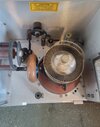 20220920_170854.jpg2.1 MB · Views: 358
20220920_170854.jpg2.1 MB · Views: 358 -
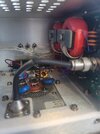 20220920_170913.jpg1.3 MB · Views: 425
20220920_170913.jpg1.3 MB · Views: 425 -
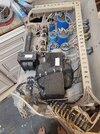 20221120_005525.jpg2.1 MB · Views: 366
20221120_005525.jpg2.1 MB · Views: 366 -
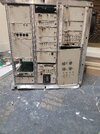 20221120_010713.jpg2.2 MB · Views: 338
20221120_010713.jpg2.2 MB · Views: 338 -
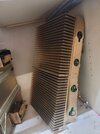 20221120_010833.jpg1.4 MB · Views: 333
20221120_010833.jpg1.4 MB · Views: 333 -
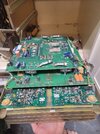 20221120_010855.jpg2 MB · Views: 384
20221120_010855.jpg2 MB · Views: 384 -
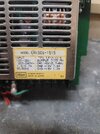 20221120_011157.jpg2 MB · Views: 345
20221120_011157.jpg2 MB · Views: 345 -
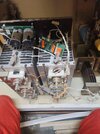 20221120_011259.jpg1.7 MB · Views: 372
20221120_011259.jpg1.7 MB · Views: 372 -
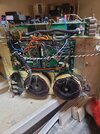 20221120_011439.jpg1.6 MB · Views: 328
20221120_011439.jpg1.6 MB · Views: 328 -
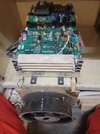 20221120_011423.jpg1.7 MB · Views: 347
20221120_011423.jpg1.7 MB · Views: 347
Sure sounds like what you need is for someone to look at it and tell you what you have.
Kinda hard to locate a market for your stuff until you can identify who that market is. Sounds like you're looking for someone who builds amplifiers and buys big parts to do it.
I will suggest one possible fly in the ointment. Not all large power tubes are amplifiers. Industrial RF generators will use a tube in a big power oscillator circuit. This kind of tube has very low gain, and won't multiply the power level enough to build a satisfactory amplifier. This kind of industrial oscillator is used to melt plastic, weld plastic or generally heat stuff up with RF.
If that's what you have it won't be as sexy as actual amplifier components.
One bad surprise that comes with an industrial RF heater is in the power supply. It will generally be designed to hold the power down to a safe level for the tube. Using this kind of transformer for a linear amplifier holds down the wattage. Not what the linear operator wants.
But what you really need is for someone who can tell the difference to look it over. Then you'll know if all my warnings are just wasted hot air, or if they'll turn out to be actual bad news.
Maybe some pics would be a good start?
73
Kinda hard to locate a market for your stuff until you can identify who that market is. Sounds like you're looking for someone who builds amplifiers and buys big parts to do it.
I will suggest one possible fly in the ointment. Not all large power tubes are amplifiers. Industrial RF generators will use a tube in a big power oscillator circuit. This kind of tube has very low gain, and won't multiply the power level enough to build a satisfactory amplifier. This kind of industrial oscillator is used to melt plastic, weld plastic or generally heat stuff up with RF.
If that's what you have it won't be as sexy as actual amplifier components.
One bad surprise that comes with an industrial RF heater is in the power supply. It will generally be designed to hold the power down to a safe level for the tube. Using this kind of transformer for a linear amplifier holds down the wattage. Not what the linear operator wants.
But what you really need is for someone who can tell the difference to look it over. Then you'll know if all my warnings are just wasted hot air, or if they'll turn out to be actual bad news.
Maybe some pics would be a good start?
73
I attached a few pictures of some of the parts I have.Sure sounds like what you need is for someone to look at it and tell you what you have.
Kinda hard to locate a market for your stuff until you can identify who that market is. Sounds like you're looking for someone who builds amplifiers and buys big parts to do it.
I will suggest one possible fly in the ointment. Not all large power tubes are amplifiers. Industrial RF generators will use a tube in a big power oscillator circuit. This kind of tube has very low gain, and won't multiply the power level enough to build a satisfactory amplifier. This kind of industrial oscillator is used to melt plastic, weld plastic or generally heat stuff up with RF.
If that's what you have it won't be as sexy as actual amplifier components.
One bad surprise that comes with an industrial RF heater is in the power supply. It will generally be designed to hold the power down to a safe level for the tube. Using this kind of transformer for a linear amplifier holds down the wattage. Not what the linear operator wants.
But what you really need is for someone who can tell the difference to look it over. Then you'll know if all my warnings are just wasted hot air, or if they'll turn out to be actual bad news.
Maybe some pics would be a good start?
73
Thanks for taking the time to help me.Data Sheet below.
73
Jeff
I seen it, but that's a different language to this guy! Lol. I understand that it's showing it's capabilities and limits, but what it takes to safely fire one up is beyond me... heck I don't even know what a grid is lol. I know...pathetic.Thanks for taking the time to help me.
The big metal power tube looks like a 5000-Watt size. Could be wrong. The type number printed on it tells the story of what it can or can't do if you seek to repurpose it as a power amplifier for a radio.
73
73
dxChat
- No one is chatting at the moment.
-
-
-
-
@ boniface95:Hi there, I just posted this question, if anyone has time to check it out, i'd really appreciate some feedback. https://www.worldwidedx.com/threads...-radio-transmitters-in-the-same-space.270736/
-
dxBot:Kangsteri has left the room.
